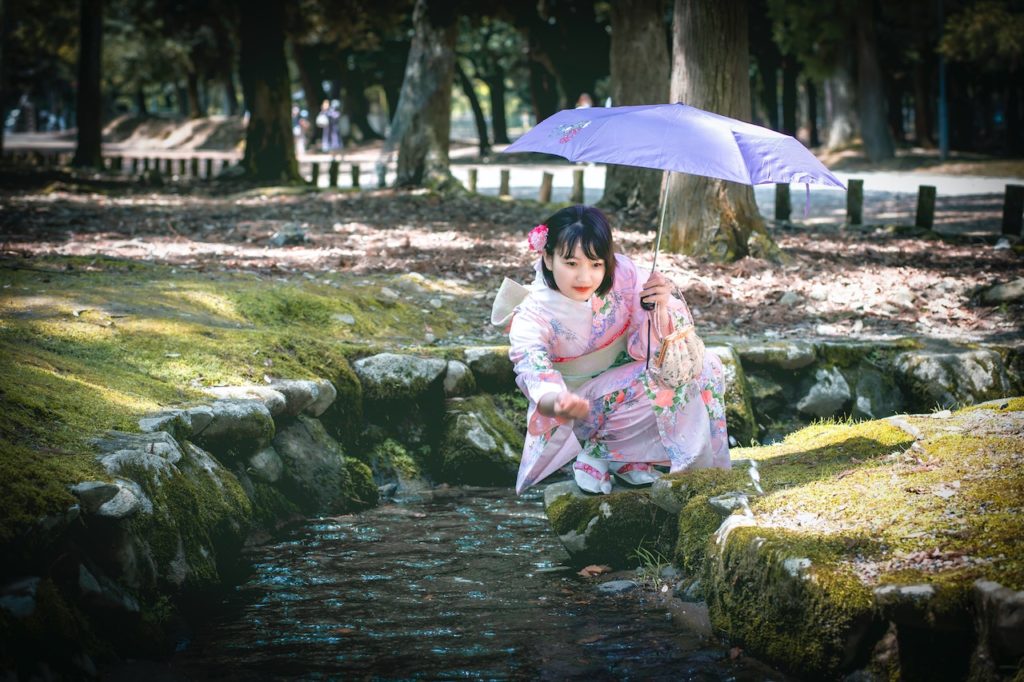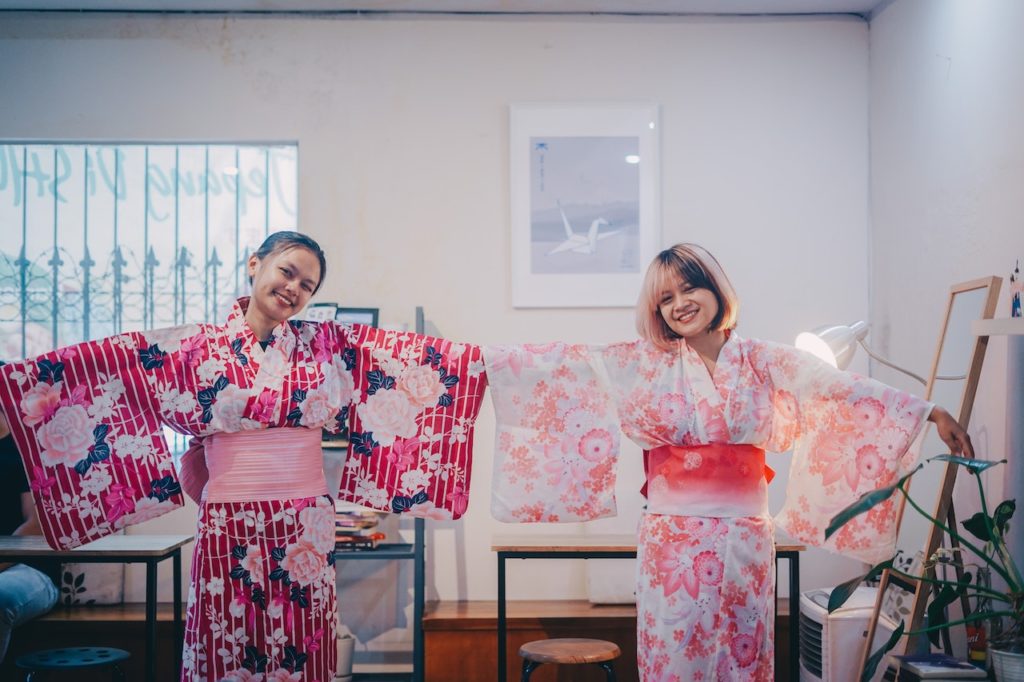What’s the difference?
Yukata and Kimono stand as two captivating symbols of tradition and beauty. These graceful garments are more than just clothing; they are intricate tapestries woven with centuries of history, artistry, and cultural significance. Often worn during festivals, ceremonies, and special occasions, the Yukata and Kimono hold distinct places in the hearts of the Japanese people and curious travelers alike. Let us embark on a journey through the vibrant threads that compose these timeless pieces of attire and discover the nuanced differences that set them apart.
Yukata: Relaxed Charm
The Yukata, a delightful cotton kimono, exudes a sense of relaxed charm that makes it a popular choice during the summer months and at various informal events. Originally worn as a bathrobe in the luxurious hot spring resorts of Japan, the Yukata transformed into a casual garment that graced summer festivals and fireworks displays. Its lightweight and breathable fabric is perfect for beating the summer heat, while its loose-fitting nature ensures comfort and freedom of movement.
Fabric and Design
Yukatas are primarily crafted from cotton, rendering them comfortable and breathable. Their designs are often characterized by bold, vibrant patterns, making them a canvas for artistic expression. These patterns range from lovely florals to geometric shapes, showcasing the diverse tastes of wearers. The Yukata’s dynamic color palette is reflective of the season in which it is worn; cheerful hues dominate the summer months, whereas cooler tones are chosen for autumnal events.
Occasions
The Yukata’s versatility shines through its adaptability to various informal occasions. Whether strolling through a bustling summer festival or enjoying a Hanabi (fireworks) display, the Yukata adds a touch of festivity without compromising comfort. Its relaxed nature makes it a favorite among both the young and the old, ensuring that everyone can partake in Japan’s cultural celebrations with ease and style.
Kimono: Elegance Personified
The Kimono, a timeless and iconic garment, stands as a symbol of utmost elegance and formality in Japanese culture. With its intricate construction, luxurious materials, and intricate accessories, the Kimono has graced special events, ceremonies, and historical occasions for centuries. While the Kimono has experienced transformations over time, its status as a regal attire has remained unshaken.
Fabric and Design
Kimonos are typically made from silk, lending them a luxurious feel and a distinctive sheen. The patterns adorning kimonos often tell stories, embody nature’s beauty, or convey wishes for prosperity. These designs can be woven, dyed, or embroidered, each technique contributing to the overall allure of the garment. Kimonos are meticulously tailored with a series of T-shaped panels that are carefully sewn together, creating a seamless flow of fabric that envelops the wearer in elegance.
Occasions
Kimonos are reserved for special occasions, serving as a mark of reverence and respect. They are the attire of choice for weddings, tea ceremonies, and traditional theater performances. The Kimonos grandeur and intricate details highlight the significance of the events it graces, and wearing one is not just a sartorial choice, but a way of honoring tradition and culture.
Differences: A Threadbare Analysis
The comparison between the Yukata and Kimono extends beyond their distinct formalities and purposes. These differences reveal themselves in intricate ways, shaping the cultural narrative and the wearer’s experience.
1. Historical Roots
The roots of the Yukata and Kimono trace back through centuries of Japanese history. The Yukata, born from the luxurious bath robes of the past, carries an air of relaxation and simplicity. It symbolizes the leisurely pursuits of summer festivals and communal enjoyment. On the other hand, the Kimono’s lineage is rooted in aristocratic and samurai heritage. It stands as a representation of elegance, reserved for revered ceremonies and occasions of solemnity.
2. Layering and Complexity
The art of wearing a Yukata is relatively straightforward, requiring minimal layering and accessories. The garment is donned with ease, making it an ideal choice for those new to traditional Japanese attire. Conversely, the Kimono demands a more intricate approach. Wearing a Kimono involves multiple layers, delicate obi belts, and an array of complementary accessories like kanzashi hair ornaments. This complexity elevates the Kimono-wearing experience to an elaborate ritual that reflects the respect for tradition.
3. Socio-Cultural Significance
The Yukata is a joyful embodiment of inclusivity, inviting people of all ages to partake in summer festivities. Its casual nature encourages community engagement, enabling everyone to immerse themselves in the spirit of celebration. In contrast, the Kimono is a reflection of hierarchy and protocol. It carries a weight of formality that underlines its use in important life events, reflecting respect for tradition and cultural hierarchy.
4. Seasonal Symbolism
The Yukata and Kimono are intrinsically tied to Japan’s seasons, reflecting the country’s reverence for nature’s cyclical changes. The Yukata bursts forth during the vibrant summers, mirroring the exuberance of the season’s festivals and outdoor gatherings. Kimonos, in their rich silks and intricate designs, echoes the depth of autumnal and wintertime occasions. These garments harmonize with nature’s rhythm, making them more than mere clothing; they are living embodiments of the passing seasons.
5. Artistic Expression
Both the Yukata and Kimono allow for artistic expression, albeit in different ways. The Yukata’s larger canvas serves as a playground for vibrant patterns that celebrate life’s effervescence. Its more relaxed design allows for daring color combinations and playful motifs. In contrast, the Kimono’s smaller canvas is a realm of refined subtlety. Its intricate designs require a discerning eye to appreciate the stories woven into each thread, making it a canvas for exquisite, meticulous artistry.
6. Accessibility and Adaptability
The Yukata’s accessibility stems from its design simplicity and comfortable wear. It appeals to a wide range of people, transcending age and familiarity with traditional clothing. The Kimono, with its intricate layers and tying techniques, demands experience, and expertise to wear correctly. This exclusivity, while enhancing its elegance, also limits its practicality in modern daily life.
7. Symbolism of Accessories
Accessories play a pivotal role in differentiating the Yukata and Kimono. Yukatas are often paired with simple, comfortable geta sandals and a casual obi belt. These accessories complement the Yukata’s carefree nature. Conversely, the Kimono is accompanied by elaborate obi belts and an array of accessories like hairpins, undershirts, and intricate footwear. These additional elements contribute to the Kimono’s elevated formality.
8. Modern Adaptations
In recent years, both the Yukata and Kimono have experienced modern adaptations that bridge tradition with contemporary fashion. Designers have infused new elements into Yukata patterns and styles, making them accessible for everyday wear. Similarly, modern Kimonos incorporate elements from Western fashion, such as shorter sleeves and simplified obi belts, making them more approachable for younger generations.
9. Cultural Preservation
While both the Yukata and Kimono continue to hold cultural significance, their preservation efforts differ. The Yukata’s relaxed nature aligns with Japan’s ongoing summer festival traditions, ensuring its continuous relevance. In contrast, the Kimono’s preservation often involves dedicated artisans passing down traditional techniques, as well as cultural organizations working to maintain its legacy.
10. Evolution in Identity
The Yukata and Kimono are reflective of Japan’s evolving cultural identity. The Yukata captures the spirit of a nation that embraces modernity while cherishing its roots. It’s a celebration of community, freedom, and unity. The Kimono embodies Japan’s profound respect for its heritage, representing the nation’s commitment to maintaining its cultural legacy in a world of rapid change.

Conclusion
In the intricate tapestry of Japanese culture, the Yukata and Kimono are not merely clothing; they are threads woven from history, tradition, and artistry. Their differences tell stories of Japan’s diverse facets, from carefree festivities to solemn ceremonies, from vibrant patterns to intricate designs. As we explore these differences, we uncover the heartbeat of a nation, resonating through the garments that encapsulate its essence. The next time you glimpse a Yukata or Kimono, remember that you’re witnessing more than just attire – you’re witnessing the continuation of a timeless journey.
